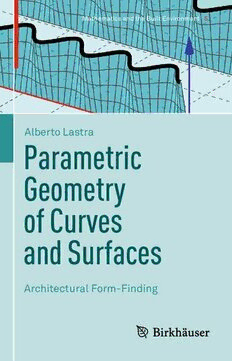Table Of ContentMathematics and the Built Environment 5
Alberto Lastra
Parametric
Geometry
of Curves
and Surfaces
Architectural Form-Finding
Mathematics and the Built Environment
Volume 5
SeriesEditors
MichaelOstwald , BuiltEnvironment,UniversityofNew SouthWales, Sydney,
NSW,Australia
KimWilliams,KimWilliamsBooks,Torino,Italy
EditedbyKimWilliamsandMichaelOstwald.
Throughout history a rich and complex relationship has developed between
mathematicsandthevariousdisciplinesthatdesign,analyse,constructandmaintain
thebuiltenvironment.
This book series seeks to highlight the multifaceted connections between the
disciplinesofmathematicsandarchitecture,throughthepublicationofmonographs
thatdevelopclassicalandcontemporarymathematicalthemes–geometry,algebra,
calculation,modelling.These themesmay be expandedin architectureof anyera,
culture or style, from Ancient Greek and Rome, through the Renaissance and
Baroque,toModernismandcomputationalandparametricdesign.Selectedaspects
ofurbandesign,architecturalconservationandengineeringdesignthatarerelevant
forarchitecturemayalsobeincludedintheseries.
Regardlessofwhetherbooksinthisseriesarefocusedonspecificarchitecturalor
mathematicalthemes,theintentionistosupportdetailedandrigorousexplorations
ofthehistory,theoryanddesignofthemathematicalaspectsofbuiltenvironment.
Moreinformationaboutthisseriesathttp://www.springer.com/series/15181
Alberto Lastra
Parametric Geometry
of Curves and Surfaces
Architectural Form-Finding
AlbertoLastra
DepartamentodeFísicayMatemáticas
UniversidaddeAlcalá
AlcaládeHenares,Spain
ISSN2512-157X ISSN2512-1561 (electronic)
MathematicsandtheBuiltEnvironment
ISBN978-3-030-81316-1 ISBN978-3-030-81317-8 (eBook)
https://doi.org/10.1007/978-3-030-81317-8
MathematicsSubjectClassification:53A04,53A05,00A67
©TheEditor(s)(ifapplicable)andTheAuthor(s),underexclusivelicensetoSpringerNatureSwitzerland
AG2021
Thisworkissubjecttocopyright.AllrightsaresolelyandexclusivelylicensedbythePublisher,whether
thewhole orpart ofthematerial isconcerned, specifically therights oftranslation, reprinting, reuse
ofillustrations, recitation, broadcasting, reproductiononmicrofilmsorinanyotherphysicalway,and
transmissionorinformationstorageandretrieval,electronicadaptation,computersoftware,orbysimilar
ordissimilarmethodologynowknownorhereafterdeveloped.
Theuseofgeneraldescriptivenames,registerednames,trademarks,servicemarks,etc.inthispublication
doesnotimply,evenintheabsenceofaspecificstatement,thatsuchnamesareexemptfromtherelevant
protectivelawsandregulationsandthereforefreeforgeneraluse.
Thepublisher,theauthors,andtheeditorsaresafetoassumethattheadviceandinformationinthisbook
arebelievedtobetrueandaccurateatthedateofpublication.Neitherthepublishernortheauthorsor
theeditorsgiveawarranty,expressedorimplied,withrespecttothematerialcontainedhereinorforany
errorsoromissionsthatmayhavebeenmade.Thepublisherremainsneutralwithregardtojurisdictional
claimsinpublishedmapsandinstitutionalaffiliations.
Thisbookis published underthe imprint Birkhäuser, www.birkhauser-science.com, bythe registered
companySpringerNatureSwitzerlandAG.
Theregisteredcompanyaddressis:Gewerbestrasse11,6330Cham,Switzerland
Amis abuelos
Preface
The parametric aspects of curves and surfaces have been studied from the point
of view of differential geometry through history. Indeed, many different studies
havebeendevelopedsince the nineteenthcenturyon thisdiscipline,which canbe
found in detail in texts such as do Carmo (1976), Tapp (2016), Umehara et al.
(2017). Apart from the theoretical relation of a curve (or surface) to any of its
parametrizations, one can go a step further and describe it from a practical point
of view. The geometric scheme of a curve or a surface has provided inspiration
for numerous works of art and architecture. These creations not only respond to
physicalneedssuchascertainacousticproperties,lighting,etc.,butalsotoahuman
desire to createstructureswith simple geometricshapes. Thisbooksdescribesthe
classicaltheoryofparametrictoolsinthegeometryofcurvesandsurfaceswithan
emphasisonapplicationstoarchitecture.
Thisbookisbasedonadecadeofteachingaclassongeometryinarchitectural
studies at Universidad de Alcalá (Spain). This class, “Drawing Workshop II”,
combinedarchitectural design and mathematics. Nevertheless, it can also be used
as a text on differential geometry for mathematics students, or a basic reference
onmathematicsforarchitectsanddesigners(especiallythoseworkingwithCAD).
I hope that the latter will find this text useful and interesting, shedding light on
thetheoreticalaspectsoftheirwork,aswellasontheapplicabilitytoarchitecture.
Thetechniquesusedintheexamplesprovidedinthetextserveasthemathematical
realizationofmanygeometrictoolsusedinCADprogramssuchastheconstruction
of an helix,extrusions,revolutionor ruledsurfaces, projections,and manyothers.
I also provide algorithms related to some of the geometric objects and show how
differentactionsontheparametrizationschangethenatureofthegeometricobject
itself. These mathematical tools are important to understand the structure of a
geometricobjectandtoknowhowtomodifyitconsciously.
Thestructureofthebookisasfollows.
The first chapter is devoted to the study of parametrization of plane curves,
with special focus on conics. In this chapter, the implicitation and approximation
ofcurvesisalsoillustratedwithgeometricexamples.
vii
viii Preface
Fig.1 Structureofthebook
Thesecondchapterdescribesaparalleltheoryonspacecurves,andtheappear-
anceofsuchcurvesinarchitecture.Geometrictransformationsareperformedona
spacecurve,makingexplicitthemathematicsbehindusualactionsincurvedesign.
The third and fourthchaptersconsider,respectively,generalsurfacesand other
particular classes of surfaces which are of widespread use. The examples range
fromclassic surfacesin architectureto the parametrizationof such familiesor the
constructionofotherwhichremainofparticularinterestregardingtheirproperties.
Moreprecisely,wefocusonsomecurveslyingonsurfacesandontheintersection
ofcurves.Surfacessuchasquadrics,ruledsurfaces,surfacesofrevolution,minimal
anddevelopablesurfacesarealsostudiedandappliedtoarchitecturalelements.
ThestructureofthebookisillustratedinFig.1.
Themathematicalprerequisitesforthisbookarefirstcoursesintopology,linear
algebra and calculus (both single and multi- variable), as amply covered in the
books Salas et al. (2003), Marsden and Tromba (2012), and Lang (1986); Strang
(1993). For completeness, we have included two appendices covering knowledge
thatwillbeusefulforunderstandingthematerial.
ThefiguresofgeometricobjectshavebeencreatedwithGeogebrasoftware.
I want to express my gratitude to everyone who was involved in this class,
speciallytoProf.ManueldeMiguel,whointroducedmetotheworldofarchitecture.
I also want to express my gratitude to Remi Lodh, who has guided me on its
publicationwithhighprofessionalismandalsotoKimWilliamsforherenthusiasm,
professionalismandeffortintherevisionofthemanuscript,andalsogivingrelevant
andinterestingdetails.
Suggested FurtherReading
The following sources are suggested to interested readers seeking additional
material (AAG 2008, 2010, 2013, 2014, 2016, 2018; Bridges 2003, 2004, 2008,
2011,2012,2014,2016,2018).
AlcaládeHenares,Spain AlbertoLastra
2021
Contents
1 ParametrizationsandPlaneCurves ....................................... 1
1.1 PlaneCurvesandParametrizations.................................... 2
1.2 SomeClassicCurvesinArchitecture.................................. 9
1.3 SomeElementsofRegularPlaneCurves.............................. 15
1.4 Conics................................................................... 26
1.5 SomeConicsinArchitecture........................................... 38
1.6 OntheImplicitationandParametrizationofCurves.................. 41
1.7 ApproximationandInterpolationofCurves........................... 51
1.8 SuggestedExercises.................................................... 55
2 ParametrizationsandSpaceCurves....................................... 59
2.1 SpaceCurvesandParametrizations.................................... 59
2.2 SomeElementsofRegularSpaceCurves............................. 66
2.3 SomeClassicSpaceCurvesinArchitecture .......................... 87
2.4 RigidTransformationsinR3........................................... 90
2.5 SomeTransformationsonaHelix ..................................... 96
2.6 SuggestedExercises.................................................... 101
3 ParametrizationsandRegularSurfaces................................... 103
3.1 SurfacesandParametrizations......................................... 103
3.2 SomeClassicSurfacesinArchitecture................................ 116
3.3 ProjectionsofSurfacesontoPlanes ................................... 123
3.4 CurvesinSurfacesandIntersectionofSurfaces...................... 126
3.5 SuggestedExercises.................................................... 136
4 SpecialFamiliesofSurfaces ................................................ 139
4.1 RuledSurfaces.......................................................... 139
4.2 SomeSubfamiliesofRuledSurfaces.................................. 148
4.3 ParametrizationofSomeRuledSurfaces.............................. 154
4.4 SurfacesofRevolution ................................................. 160
4.5 QuadricSurfaces........................................................ 169
4.6 QuadricsRevisited:SomeExamplesinArchitecture................. 187
ix
x Contents
4.7 Curvature:MinimalandDevelopableSurfaces....................... 190
4.7.1 FinalComments ............................................... 200
4.8 SuggestedExercises.................................................... 201
A CoordinateSystems.......................................................... 205
B MathematicalToolKit....................................................... 213
B.1 IntroductiontoLinearAlgebra......................................... 213
B.1.1 SystemsofLinearEquations.................................. 213
B.1.2 VectorSpaces .................................................. 214
B.1.3 EuclideanVectorSpaces....................................... 215
B.1.4 Diagonalization:EigenvaluesandEigenvectors.............. 215
B.2 RealFunctionsofOneVariable........................................ 216
B.3 FunctionsofSeveralRealVariables................................... 219
B.4 DifferentialEquationsandSystemsofDifferentialEquations....... 221
C SolutiontotheSuggestedExercises........................................ 223
C.1 Chapter1................................................................ 223
C.2 Chapter2................................................................ 235
C.3 Chapter3................................................................ 245
C.4 Chapter4................................................................ 249
References......................................................................... 267
Index............................................................................... 273

